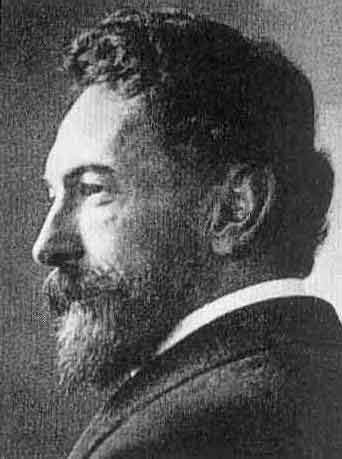
Richard Adolf Zsigmondy, Chemistry Stamps
| Richard Adolf Zsigmondy | |
| Born | April 1, 1865 Vienna, Austrian Empire |
|---|---|
| Died | September 23, 1929 (aged 64) Göttingen, Germany |
| Nationality | Austrian |
| Institutions | University of Vienna Technical University of Vienna University of Munich University of Graz University of Göttingen |
| Doctoral advisor | Wilhelm von Miller |
| Influenced | August Kundt |
| Notable awards | Nobel Prize in Chemistry 1925 |
Richard Adolf Zsigmondy (April 1, 1865 in Vienna, Austrian Empire (now Austria) - September 23, 1929 in Göttingen, Germany) was an Austrian-German chemist of Hungarian ancestry who studied colloids. He won the Nobel Prize in Chemistry in 1925. The Zsigmondy crater on the moon is named in his honor.
Early life
Zsigmondy was born to Irma von Szakmary and Adolf Zsigmondy Sr., who had been a scientist and had invented surgical instruments in the field of dentistry. He was brought up by his mother after his father's early death in 1880 and received a comprehensive education while nevertheless enjoying hobbies such as climbing and mountaineering with his siblings. His brother Karl Zsigmondy became a notable mathematician in Vienna. In high school he developed an interest in natural science, especially in chemistry and physics and started to carry out experiments in his own home laboratory.
Education
His academic career began at the University of Vienna Medical Faculty, but soon moved on to the Technical University of Vienna and later to the University of Munich in order to study chemistry. In Munich his teacher was Wilhelm von Miller (1848-1899), where he started his scientific career by concluding research on indene[1] and receiving his Ph.D. in 1889.

Richard Adolf Zsigmondy
Academic and Industry Career
He left organic chemistry and joined the physics group of August Kundt at the University of Berlin and finished his habilitation at the University of Graz in 1893.
Because of his kowledge about glass and its colouring in 1897 the Schott Glass munufactory offered him a job which he accepted. He invented the Jenaer Milchglas and conducted some research on the red Rubby glass.
He left Schott Glass in 1900 but staid in Jena as privat lecturer to conduct his research. Together with the optical instrument manufacturer Zeiss he developed the the slit ultramicroscope.
His scientific career continued in 1908 at the University of Göttingen as professor for inorganic chemistry where he remained the rest of his professional career. In 1925 Zsigmondy received the Nobel Prize for Chemistry for his work on colloids during his time in Graz and Jena.
Private life
During his time in Jena he married Laura Luise, née Müller. Two daughters, Annemarie and Käthe, resulted from this marriage.
He died only a few years after retirement in 1929 in Göttingen.
Scientific work
Even before he finished his PhD thesis in organic chemistry he published research on the clouring of glass with silver salts and dissolved silver particles which he recovered by dissolving the glass in hydrofluoric acid.
During his work in Graz he accomplished his most notable research work, the work on the chemistry of colloids (a certain coloured glass). The exact mechanism which yields the red colour of the Cranberry or Ruby glass was a result of his studies of colloids [2] In later years he worked on gold hydrosol and used them to caractarize protein solutions During his time in Jena he developed the slit ultramicroscope.
References
1. ^ W. v. Miller, Rohde (1889). "Zur Synthese von Indenderivaten". Berichte der deutschen chemischen Gesellschaft 22 (2): 1881 - 1886. doi:10.1002/cber.18890220227.
2. ^ R. Zsigmondy (1898). "Ueber wässrige Lösungen metallischen Goldes". Justus Liebig's Annalen der Chemie 301 (1): 29-54. doi:10.1002/jlac.18983010104.
Further
* J. Reitstötter (1966). "Richard Zsigmondy". Journal Colloid & Polymer Science 211 (1-2): 229-234. doi:10.1007/BF01500203.
* "R. Zsigmondy (1865–1929)" (1965). Nature 206 (4980): 139. doi:10.1038/206139a0.
* Lottermoser (1929). "Richard Zsigmondy zum Gedächtnis". Zeitschrift für Angewandte Chemie 42 (46): 1069-1070. doi:10.1002/ange.19290424602.
* "Richard Zsigmondy zum 60. Geburtstage" (1925). Zeitschrift für Angewandte Chemie 38 (14): 289 - 289. doi:10.1002/ange.19250381402.
* H. Freundlich (1930). "Richard Zsigmondy zum 60. Geburtstage". Berichte der deutschen chemischen Gesellschaft 63 (11): A171 - A175. doi:10.1002/cber.19300631144.
Retrieved from "http://en.wikipedia.org/"
All text is available under the terms of the GNU Free Documentation License

